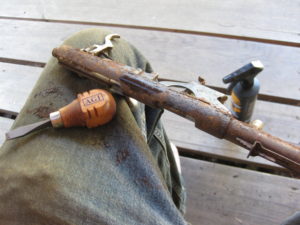
Rust and Corrosion
By: Robert Dunn
Rust and corrosion has enabled me to make money since I can remember, but it’s not my friend. When I was very young, I remember getting a small bump in my allowance for cleaning up a bunch of rusty parts for something my Dad was rebuilding with a product called Naval Jelly (phosphoric acid). I guess I did a good job because it wasn’t too long until I graduated to helping him strip and clean the barrel and receiver of his new deer rifle, a sporterized Springfield 1903A3! We then cold blued the rifle. That finish has lasted for over 40 years and it still looks good! Bluing itself is a form of corrosion, but I will touch on that later in this article.
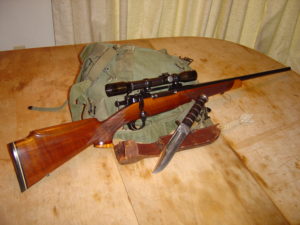
Over 40 years after my Dad and I cold blued his Springfield rifle, it still looks great!
My Mom was an antique dealer and she was always bringing home things that either needed to be cleaned up or it was adamantly left untouched, as the patina of certain collectables increased its value. I spent many hours with wire brushes, steel wool and other tools and products to help restore many items that came into our possession. Corrosion and rust seem to follow me around. Living on the East Coast, many places salt their roads during the winter to combat the snow and ice. I always thought it was a shame to see the quarter panels and frames from all the cool 1960s muscle cars whittled away during the 70s! When my family moved to Puerto Rico for a few years, I was really amazed at how fast anything made of metal would rust away to nothing. Living on a small island means that you are surrounded by salt water and the air has salt in it too. You could never be far enough inland to be safe from corrosion. Living in these conditions made me conscious of atmospheric corrosion and interested in how to stop these deteriorating processes.
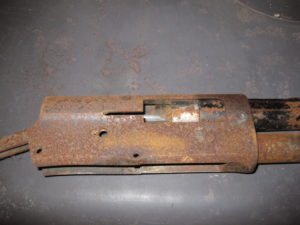
Corrosion is a problem with firearms. Not only can the metal parts corrode but the wood and plastic parts are also susceptible to corrosion. Rust and corrosion are bad for your firearms because they reduce the life of your gun and can ultimately cause the weapon to fail! Corrosion can also reduce the value of you firearm. Being a good gun owner should involve taking steps to prevent rust and corrosion from effecting your firearms.
I have done my share of car restoration over the years, but these days my projects seem to be firearms that have been mistreated, uncared for or stored improperly. I have tried various techniques for getting rid of rust and keeping it at bay. For years I have watched my friends, Bob Dunlap and Ken Brooks conduct experiments on old frames and barrels to test how well various lubricants and finishes hold up to the harsh Oregon weather conditions. Where we live is not too far from the coast and the salty air attacks our prized possessions. There is probably a good reason that they use Ballistol and Break Free CLP.
When I studied chemistry, I found it interesting to learn about rust (iron oxide) and corrosion (electrochemical oxidation). Many of the tools and recreational devices that I enjoy using are made of some type of common metal, like steel and iron. These materials are selected because of their strength, not necessarily for their anti-corrosion properties and because of this, we have devised many ways to help prevent rust and corrosion. Things like paint, plating and other processes and finishes can help to keep corrosion to a minimum. Another way to keep corrosion to a minimum in metals is to create an alloy, which is a combination of two or more metallic elements. Stainless steel, which is a steel alloy that contains chromium, is a good example that is commonly used in the firearms industry, as it is corrosion resistant and retains good tensile strength.
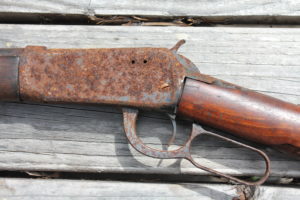
Rust is a form of corrosion that results in a visibly red or sometimes yellowish porous surface texture. This is caused by the reaction of iron and oxygen when exposed to moisture (oxidation). The alloys that are used for manufacturing firearms are prime candidates for being violated by rust and corrosion as they are exposed to inadequate storage conditions, harsh weather, salts from your body as well as atmospheric conditions and exposure to solvents and chemicals. This is a reason why military testing in the “real world” is so valuable to firearms manufacturers.
I’m starting to feel like the “Rust Doctor” because I have brought so many rusty guns back to life. The condition of some of the firearms I have seen is sometimes hard to believe. I have spent countless hours battling the effects of rust on guns. Rust and corrosion can literally bond or fuse parts together like a good epoxy does. Prevention is the key when it comes to corrosion. If you keep your guns in a gun cabinet or safe, use a dehumidifier to keep the moisture off of your guns. Even small things like drying your gun off before stowing it will help keep corrosion away. A good practice to adhere to is to actually clean and lube your firearms after using them or at least before storing them until the next hunting season rolls around! There are many good products out there to clean and lubricate your guns. Just to name a few: Rem Oil, Slip 2000, Break Free, Ballistol, Frog Lube, etc. When it comes to maintaining and storing black powder guns, I like to use Thompson Center’s Bore Butter. It’s all natural and smells like pine!
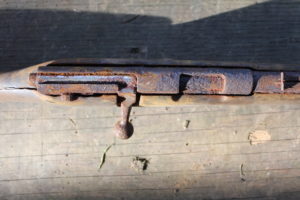
If you are dealing with a gun that has already been attacked by rust and corrosion, there are several ways that you can get it off of the firearm. Most of the time, I simply get dirty and use old sand paper with a couple drops of oil on it to take down all of the fuzzy surface rust. The oil prevents the rust particles from forming an ugly cloud in my work space. I will eventually switch to using finer and finer grades of steel wool until the job is done. I also use a variety of picks, scrapers, brushes and cotton swabs to get at small parts and tight spots. If time is of no concern or the gun is so corroded that the action won’t open or other parts will not mechanically function correctly, I will soak the gun in a vinegar bath. I have used both distilled white vinegar and apple cider vinegar and I like the apple the best for rust and the white vinegar for cleaning up the wood. This is a fairly cheap alternative to using more expensive industrial cleaners and such. With that being said, even though vinegar is an acid and works wonders on rust, sometimes you have to get out the big guns. I have used Kroil, Liquid Wrench, and BP Blaster penetrating oils on super tough jobs with good results. An old trick that I used to use on muscle cars was to mix a half and half solution of transmission fluid and acetone in an oiler can to break loose rust frozen parts. Some other solutions that I’ve used in a pinch is vegetable oil mixed with nail polish remover, paint thinner or WD-40. Trust me, these “hillbilly” penetrating oil solutions work really well.
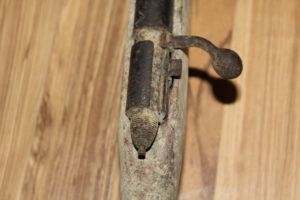
Though most of the time we are trying to prevent corrosion, sometimes we fight fire with fire and create rust or oxidation to prevent rust from occurring, as is the case with many types of passivation processes (bluing) that are used. Rust bluing involves swabbing a mixture of hydrochloric acid and nitric acid onto the parts that you want to blue. After letting the parts rust for a few days, buff them down with steel wool to reveal the black iron oxide finish. Then, rub in a bit of your favorite gun oil to prevent any further rusting.
Other methods of bluing are: cold bluing (a selenium dioxide based compound), hot caustic bluing (use of alkali salts), and fume bluing (use of nitric acid and hydrochloric acid)). There are many other techniques that are commonly used in the firearms industry to create a corrosion resistant finish on gun parts like: Parkerizing (a chemical phosphate conversion coating using manganese dioxide), niter bluing (chemical/heating process), browning, color case hardening, using a spray finish like Cerakote or DuraCoat, the use of “spray and bake” finishes. All of these methods aid in combating the effects of rust and corrosion. Proper care and maintenance of your firearms go a long way in preserving its life and value and remember, rust never sleeps!





